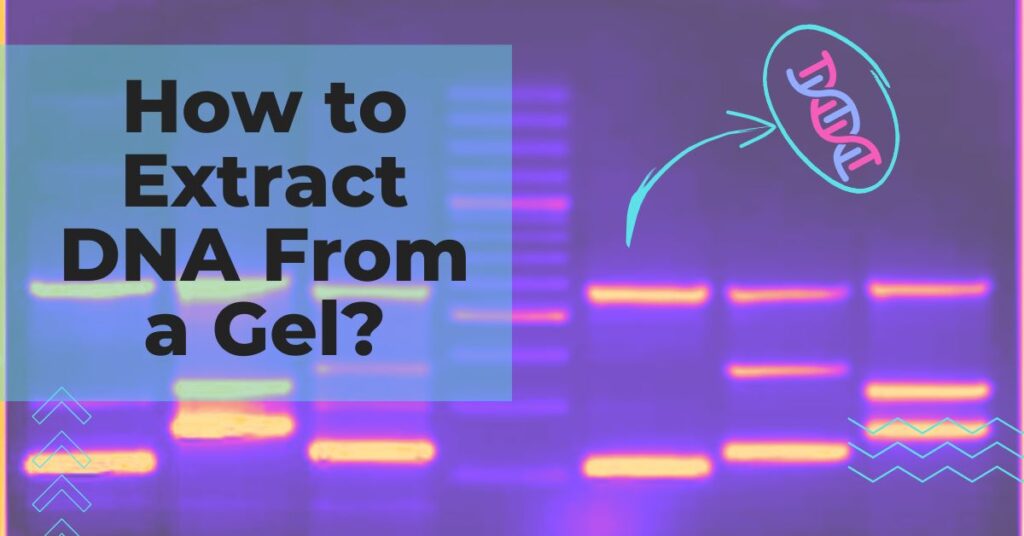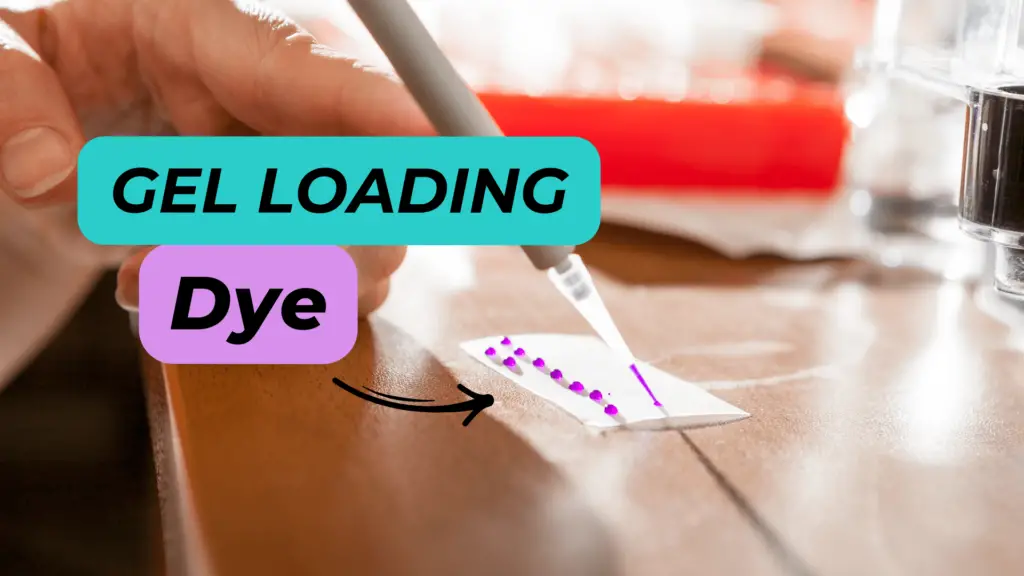“Learn about the crucial molecular genetic process- gel DNA isolation in this article. Explore how the process is done, the steps, applications, advantages and importance of isolating DNA from a gel (Bonus: troubleshooting).”
Gel DNA extraction, often known as gel DNA purification or simply gel purification is a technique to isolate DNA fragments from an agarose or PAGE gel. It’s a crucial middle process in molecular biology that allows us to isolate a desired DNA fragment.
Our target fragment can be isolated, purified and concentrated from a heterogenous mixture of fragments and used in various downstream applications. It is a crucial scheme for DNA sequencing, cloning, gene expression studies and other genetic engineering experiments.
So why do we do it, and how to perform gel DNA extraction? In this article, I will provide a comprehensive guide to the process of gel DNA isolation. In addition, key knowledge in this article are steps, protocol, applications of gel DNA isolation and importance.
At Genetic Education Inc, we often re-discover knowledge, but we add our valuable practical experience and make the learning more engaging and understandable. The basic learning module here is “gel DNA purification.”
Related article: How to Select The Most Effective Genetic Assay?
Stay tuned.
Key Topics:
What is gel DNA extraction? Why do we do it?
The pivotal limitation of molecular biology experiments is using/isolating/recovering a specific DNA fragment. Any molecular biology experiment is a combination of processes. Each step should be validated which eventually results in the loss of our DNA fragment.
Gel DNA isolation is an impressive technique to recover the desired DNA sequence readily from the gel. And let me tell you, it is routinely followed during DNA sequencing, restriction digestion, cloning, ligation and genetic engineering experiments.
The direct use of an amplified PCR product is indeed the least advised. The presence of PCR buffer ingredients, salts, primer dimers, unused dNTPs, partially amplified PCR fragments and contaminants may interfere in crucial and sensitive experiments like cloning and sequencing.
We can collect a particular DNA fragment that we want to use, purify and concentrate it through gen purification. Eventually, it increases the specificity, accuracy and results efficiency of the assay and at the same time reduces the time and cost of the experiment.

Thus, we need to do it without fail. Take a look at the reasons why it is important.
Advantages:
Specificity: Scientists can recover a desired and specific fragment for their crucial downstream applications.
Purity: As the isolate only contains the fragment of interest, it’s usually highly pure and lacks contaminants, PCR impurities, dye or buffer components. Purity ensures accuracy by reducing the probability of errors.
Concentration: a DNA fragment isolated from a gel can be concentrated to improve yield and provides ease in the experiment.
Cost-effective: gel purification is the best and most cost-effective way to recover and purify the DNA. Thus, labs are using it.
Process and steps:
The key steps involved in the process are broadly divided and discussed here in this section.
Run the electrophoresis:
The sample is run on the agarose or PAGE electrophoresis using the standard gel run protocol. Results are analyzed on the UV-transilluminator and the target DNA fragment is marked for isolation.
Excision of DNA fragment:
Now the fragment is isolated by excision from the gel matrix. It’s a simple process and can be done using a cutter, sharp scalpel, gel extraction tool or razer blade. Keep in mind that the cut should be close enough to the DNA fragment to avoid extra gel with the fragment.
Dissolving the gel:
Gel solubilization is crucial to obtain our target fragment. The fragment is dissolved in the buffer which is capable enough to solubilize it. It can be heated, afterward to dissolve the gel and release the DNA fragment. TE buffer can be used as a gel solubilizing buffer.
Bind to silica column:
Now the sample is transferred to the silica spin column and the common spin-column extraction protocol is run to purify the DNA. Gel and other contaminants are removed in this way. Follow the manufacturer’s protocol to get good results.
DNA elution:
The final collection is eluted in the elution or TE buffer. Now we have the concentrated DNA of our target DNA fragment which can be used for downstream applications.

Note: Up to 10µG DNA fragments can be recovered by the spin-column technique.
Protocol for gel DNA purification:
- Cut the gel piece containing the DNA fragment using the sterile scalpel or blade and put it in the microcentrifuge tube.
- Now add one or two volumes of the membrane binding solution (QG in case of QIAquick gel purification) which is also known as gel solubilizing buffer to the gel piece (100mg gel ~ 100µL buffer).
- Note: some literature suggests mixing by inverting for fragments >5Kb and mixing by vortexing for fragments <5Kb. Keep in mind that vortexing may shear DNA.
- Now heat the sample at 50 to 65℃ for 10 minutes, followed by mixing every minute. Heat the sample until the gel melts or dissolves. If the gel concentration is >2%, the incubation time can be increased.
- Now from here, all the steps are performed using the protocol provided by the kit manufacturer. The commonly used kit for gel elution is the QIAquick Gel Extraction Kit. So we will discuss that protocol here.
- Add an equal volume of isopropanol to the gel-containing column.
- Put it in the collection tube and spin it at 13,000 rpm for 1 minute.
- Remove the collection and add 500 µL buffer QG, spin at 13,000 rpm for 1 min.
- Remove the collection and add 750 µL washing buffer (PE) and centrifuge at 13,000 rpm for 1 min.
- Remove the collection and elute DNA using the Elution buffer. Collect the elution in a new sterile tube. Do a quality check before using it.
Applications of gel purification:
Gel purification, as aforesaid, has been an empirical step in processes like PCR amplification, DNA sequencing, cloning, genetic engineering and gene expression studies. Important applications are listed below.
PCR amplification:
To improve the yield of the desired fragment, a specific fragment can be gel purified and used for re-amplification in PCR. Copies of only desired DNA can be amplified.
DNA sequencing:
Sequencing needs a highly pure and adequate quantity of DNA fragments. Poor-quality fragments can cause errors and poor and misleading results which eventually increase the cost of the experiment. For effective sequencing library preparation in Sanger sequencing and NGS only gel-purified DNA fragments are used.
Gene cloning:
One of the important applications of gel purification is gene cloning. The target DNA sequence is amplified, purified and used in the vector. Thus, only the target sequence is cloned. The transformed plasmids are transferred into the bacteria and used for gene expression studies.
Gene expression studies:
Accurate gene expression can only be determined if we have only a desired fragment and in an adequate amount. Gel-extracted DNA can be used for probe-based hybridization for southern blotting or quantitative PCR analysis.
Challenges, troubleshooting and Tips:
The main goal to perform gel purification is to obtain a specific DNA fragment with high purity and yield, however, oftentimes, any of the goals can’t be achieved. Here are a few common problems in the process and possible troubleshooting.
| Problem | Cause | Troubleshooting |
| Low yield | Inadequate gel excision, the poor extraction process, incomplete gel solubilization and inefficient DNA binding. | Cut the gel very close to the DNA bands. Trim the gel to remove unnecessary gel portions, use the correct quantity of buffer to solubilize the gel, increase heating time to dissolve the gel thoroughly and strictly follow the manufacturer’s SOP. Use a TAE buffer for the gel run to improve the quantity. |
| Low-quality | Inadequate gel excision, poor extraction process, incomplete gel solubilization and inefficient DNA binding. | Perform and additional washing step to remove impurities. Strictly follow the manufacturer’s SOP. |
| DNA degradation | Overexposure to UV light or DNA shearing. | Avoid exposing DNA for a longer time in UV light. Avoid shearing the DNA, for example, vertex gently. Also, avoid excess agitation. |
| High background noise | Non-specific fragment. | Repeat washing or use another kit, if desired results aren’t obtained. |
| Incomplete digestion | Incomplete solubilization of agarose. Interfere in the restriction digestion process. | Increase the concentration or time for solubilization of gel. Try fine-cutting the gel without disturbing the fragment bands. |
Tips:
- Borate is a potential enzyme inhibitor, therefore, use TAE not TBE buffer if the downstream assay is associated with enzymatic activity.
- Electrophoresed using TAE buffer recovers a higher amount of DNA compared to TBE buffer.
- Select smaller-sized fragments for gel purification. Small fragments can be recovered more easily than larger-sized fragments.
- Incubate the final elute in the elution or TE buffer for 5 to 10 minutes. It will increase the yield of the recovered fragment.
- Avoid excess vertexing and high-speed centrifugation.
Wrapping up:
In conclusion, gel purification is an important technique in molecular biology research which requires careful attention to details and continuous optimizations to improve the results. Thus, expertise and experience are needed.
Learn skills to handle DNA, gel electrophoresis and solution and prepare to master your skills related to molecular genetics. I hope this article will help you. Please share it and bookmark the page for future use.

